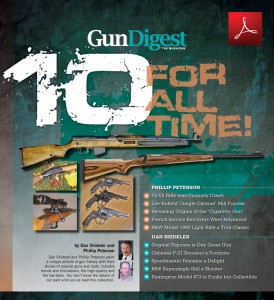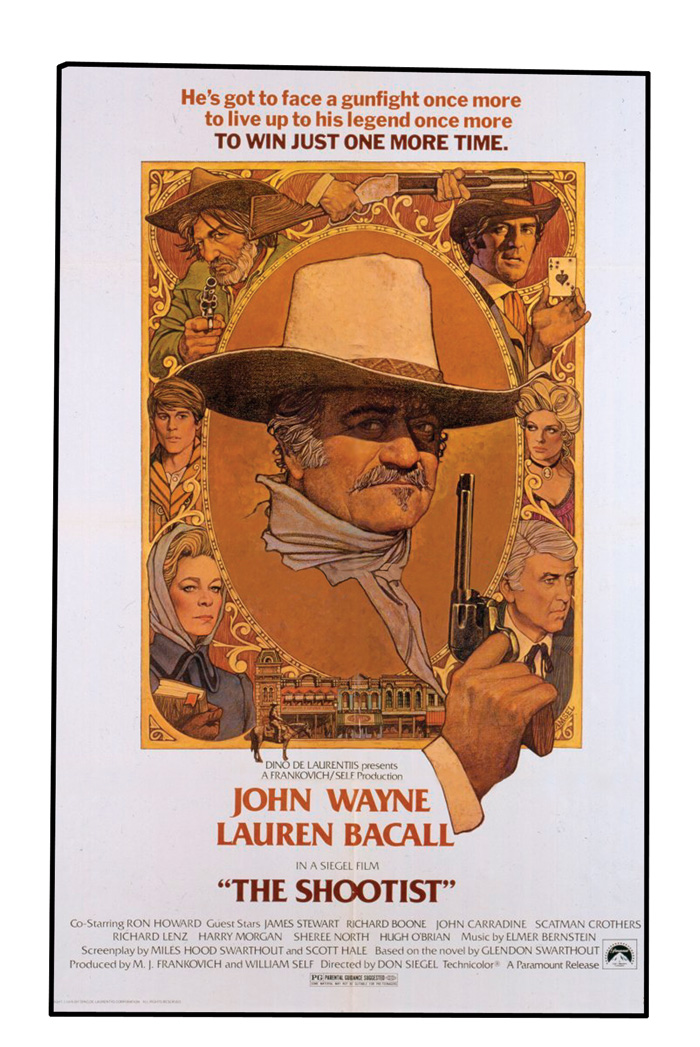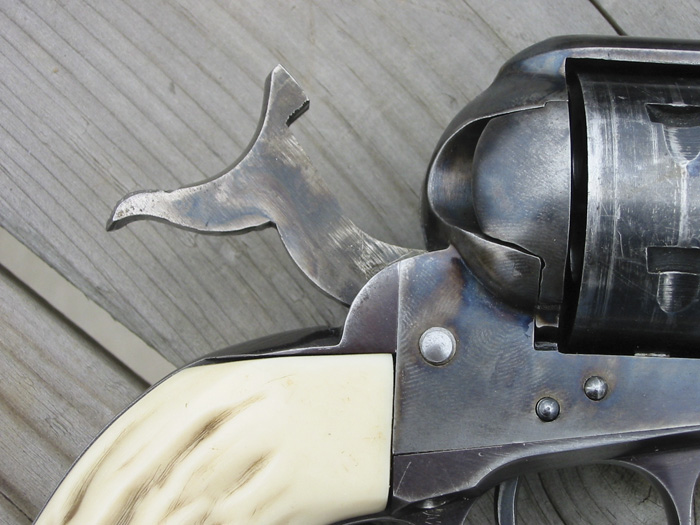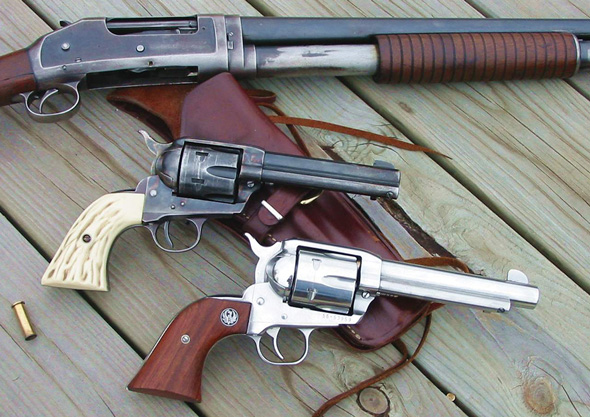 Special Offer: 10 Timeless Gun Collecting Articles from Gun Digest
Special Offer: 10 Timeless Gun Collecting Articles from Gun Digest
Articles in this Compilation: Cabanas P-21, Remington Model 673, VZ-52 Czech, Lee-Enfield Jungle Carbine, French Service Revolvers, S&W Model 1940, Model 66 Super Single, And More!
[form id=”175701″]
By Dan Shideler
Heads up, trivia buffs. Here’s a poser: In John Wayne’s last movie, The Shootist, 1976, what make and model of six-gun did he use?
Are you kidding? Everybody knows The Duke used a first-generation Colt Single-Action Army. True, he usually did. But in his final movie, Big John used a Great Western Frontier Model in .45 Colt.
Odd as it might seem today, for a brief time in the mid-1950s, revolvers made by the Great Western Arms Co. of Los Angeles, Calif., were the beau ideal of the American handgun scene. At that time, Colt’s SAA was out of production, Ruger’s Vaquero wasn’t even a twinkle in Bill Ruger’s eye, and the Italian houses of Uberti and Pietta hadn’t been founded. If you wanted an authentic, brand-new single-action .45, you wanted a Great Western.
Decline of the SAA

Today, most people don’t know Great Western, the first Colt SAA clone, existed. No wonder, because even reference books can’t get it straight. One says Great Western’s guns were imported from Germany. Wrong. Another says they were imported from Italy. Wrong. Another says the company was headquartered in Venice, Calif. Wrong. To be fair, Great Western’s brief manufacturing life span — eight years — didn’t afford much opportunity for extended scholarship. But there’s a story there nonetheless.
As everyone knows, all modern solid-frame, single-action .45s have their roots in the classic Colt Model 1873 Single Action Army (that is, the Colt Model P). With its one-piece frame, hand-fitting grip, side-mounted ejector rod and characteristic “click-click-click-click,” the Colt SAA defined an era of American history. A list of shootists who favored the SAA or its civilian counterpart, the Peacemaker, reads like a who’s who of the wild West: Emmett Dalton, Wyatt Earp, Pat Garrett, John Wesley Hardin, Teddy Roosevelt, Doc Holliday, Belle Starr, Bat Masterson, Bill Tilghman, Tom Threepersons and Elmer Keith. (Doc O’Meara presents a wonderfully readable overview of the SAA and those who preferred it in his books Guns of the Gunfighters and Colt’s Single Action Army Revolver, published by Krause Publications.)
By the end of World War I, however, the single-action .45 was on its way out. The semiauto and double-action revolver were clearly the wave of the future, and they conspired not to praise the old SAA but to bury it. From a peak of 18,000 units in 1903, SAA production dwindled to just 800-plus units in 1940, its final year. At the time, the Colt SAA was the only full-sized, fixed-sight, single-action revolver made in the United States. A relic of bygone days, it was as anachronistic in mid-20th century America as the Pony Express. Immediately after WW II, Colt discontinued the old trooper with no thought of bringing it back.
The New Old West
In the late 1940s, however, a strange thing happened: America entered a twilight zone of old-West nostalgia. Ghost Riders in the Sky by Vaughn Monroe topped the jukebox charts in 1949. Popular radio dramas included Tales of the Texas Rangers and Frontier Town. Two of the top 10 television programs of 1950 were westerns: The Lone Ranger, starring Clayton Moore, and Hopalong Cassidy with William C. Boyd. The next year, Gary Cooper won an Oscar for his portrayal of Peacekeeper-toting Sheriff Will Kane in High Noon, and the movie’s folksy theme song, Do Not Forsake Me, Oh My Darling, went top 40.
Don’t ask me how it got started. Perhaps it was a subconscious longing for a simpler, preatomic age. Regardless, thousands of middle-aged suburban men who wouldn’t know which end of a horse the feedbag goes on suddenly started wearing bolo ties and rattlesnake boots and saying “howdy.” Dude ranches sprang up across the Southwest. Everybody, it seemed, wanted to be a cowboy — or at least pretend to be one.
That popular longing for the good old days of the wild West eventually made an impression on William B. Ruger. With his keen ability for identifying trends, Ruger realized he stood at the brink of a vast new market. Investing the proceeds of his popular .22 semiauto pistol into new design and tooling, in 1953 he introduced his Single Six .22 single-action. With its 19th-century styling, the Single Six was a smash hit and proved there was a market for the single-action revolver. But as nice as the gun was — and is — it had two shortcomings: It was “just a .22,” and it wasn’t a “real Colt.”
There apparently wouldn’t be a “real Colt” any time soon. At the time, Colt Firearms Co. was sitting fat and happy with a bushel of Korean War government contracts and saw no need to resume production of an 80-year-old design. Meanwhile, prices for used SAAs, Peacemakers and Bisleys — even doggy ones — shot through the roof.
 But nature abhors a vacuum, and so did William R. Wilson, a California gun enthusiast with a strong entrepreneurial sense. There was a demand, and he would fill it. According to Bob Deubell — whose Web site, www.greatwesternfirearms.com, is a treasure trove of information — Wilson approached Colt in 1953 and asked if it planned to resurrect the SAA. Colt said the SAA was done.
But nature abhors a vacuum, and so did William R. Wilson, a California gun enthusiast with a strong entrepreneurial sense. There was a demand, and he would fill it. According to Bob Deubell — whose Web site, www.greatwesternfirearms.com, is a treasure trove of information — Wilson approached Colt in 1953 and asked if it planned to resurrect the SAA. Colt said the SAA was done.
Great Western Rises
A man on a mission, Wilson returned to Los Angeles, where he wasted no time enlisting partners and tooling up a factory on Miner Street, starting the Great Western Arms Co. Inc. to produce copies of the classic Colt SAA. Wilson was the new company’s president, and its first product was the Great Western Standard Model. Guns started rolling off the line in May 1954 and incorporated some genuine SAA components Wilson had procured from Colt.
Wilson subsequently enlisted Hy Hunter of Hollywood to handle marketing and distribution. A prominent gun retailer and firearms importer, Hunter merged the Great Western line into his existing retail and mail-order distribution channels, which were crammed with numerous Belgian, German and Italian guns. The persistent rumors that Great Western’s guns were manufactured abroad probably originated with the company’s association with Hunter. By about 1960, Hunter’s line included a West German SAA knockoff that looked pretty much like the Great Western, so perhaps you might be excused for assuming that the Great Western line was imported.
It wasn’t. All Great Western Arms Co. guns were manufactured in Los Angeles.
Except for some minor dimensional differences, the Great Western Standard Model, later called the Frontier Model, was the spirit and image of the Colt SAA in all major respects except one: its hammer. The Colt had a hammer-mounted firing pin, but the Great Western’s firing pin was mounted on the frame. The design originated with Idaho gunsmith Herb Bradley in the 1930s and was subsequently refined by Christy Gun Works of Sacramento, Calif. According to Deubell, the first several hundred Great Western Frontiers used a genuine Colt SAA hammer with integral firing pin. After 1955, a Colt-style hammer was available as an option for an additional $8.

